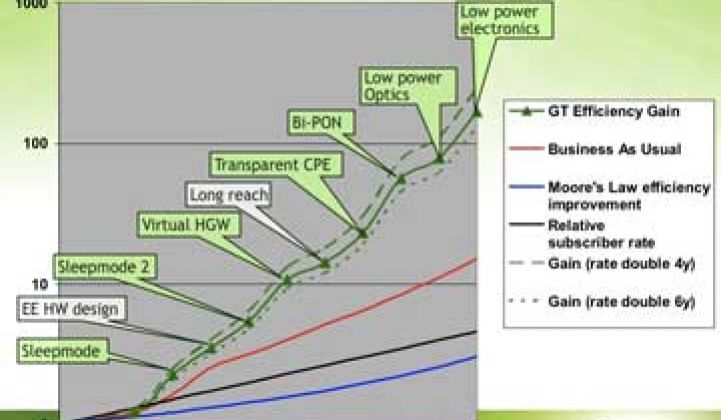When it comes to IT and energy efficiency, data centers get all of the glory. Green data centers have become a trend, and therefore big business.
But there are other areas of information technology that are also ripe for efficiency upgrades. To increase the energy efficiency of the networks themselves, the GreenTouch consortium was formed in 2010. Instead of just pushing for more than 20 percent improvements, which is the industry standard today, the industry group has set an audacious goal to make networks 1000 times more energy efficient.
The latest announcement toward that goal came on Tuesday, with unveiling of the Bit-Interleaved Passive Optical Network, or Bi-PON, which will reconfigure how data is delivered through fiber-to-the-home (FTTH).
“Today’s protocol is not designed for energy efficiency,” explained Gee Rittenhouse, chairman of GreenTouch and COO of the software, services and solutions group at Alcatel-Lucent. Fiber is already far more efficient than wireless, which GreenTouch is also working on improving. But it can do better.
The information and communications technology (ICT) industry sucks up similar energy to data centers to deliver all of information that travels through the Internet, whether wirelessly or over wired networks.
It is estimated that the ICT industry is responsible for about 2 percent of carbon emissions worldwide. As the world moves to higher-bandwidth applications, FTTH is becoming more common. Forecasts have estimated that there will be more than 140 million subscribers by 2016.
“I go around the world talking to customers, and more and more, energy efficiency is on their minds,” said Jeong Kim, president of Bell Labs. “Don’t underestimate the impact the work of the GreenTouch Consortium will have on our industry and society at large.”

Bi-PON, which builds on the existing protocol XG-PON, reconfigures how the data is sent over the fiber to the home, dropping energy use from about 3 watts per subscriber to nearly zero. “We’re showing improvements by a factor of 30,” said Peter Vetter, head of the Wireless Access Working Group.
It doesn’t sound like a lot of energy, but when taken in aggregate, it is equivalent in carbon savings to taking about 500,000 cars off of the road.
Currently, all of the data is sent from a server in packets to the end node and then processed at the end point. The result is that 99 percent of optical network units end up being discarded without being used. With Bi-PON, data will be sent in bits instead of packets and processed with a more selective technique. “It’s a very flexible way to allocate bandwidth,” said Vetter.
It is still early days, however. The new protocol will require new hardware and a new standard. GreenTouch Consortium sees this as a long-term research project that might not be in homes for at least five years, and possibly more like 10.
Once Bi-PON becomes the new protocol, it could also open up the networks to new customers. “You can think about powering this with small solar cells,” said Vetter, “and then you have a whole new way of deploying such networks.”
But GreenTouch is also looking to move in incremental steps. There are 24 other research initiatives that the group is working on. The current FTTH standard also has a definition for a rapid-cycle sleep function, which can save about half the energy used. That also requires an adaptation of the hardware, but since it is already defined in the standard, it will be in the market much sooner than Bi-PON.
Demonstrations are already underway for wireless and FTTH, with switching and routing as the next area of focus, according to Rittenhouse. And for each development, there will be a standards committee to try to get the technology out into the market as soon as possible. “We don’t want to wait until the end and try to standardize the laundry list of technologies that will achieve this result,” said Rittenhouse. “We have the laser focus of making the network itself green.”



